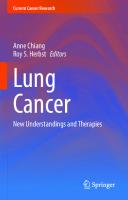Mathematical Models of Cancer and Different Therapies: Unified Framework 981158639X, 9789811586392
This book provides a unified framework for various currently available mathematical models that are used to analyze prog
221 101 6MB
English Pages 256 [267] Year 2020
Table of contents :
Preface
Contents
Abbreviations
1 Background
1.1 Introduction
1.2 Tumor Dynamics
1.2.1 Basic Mechanisms Involved in Tumor Growth
1.2.2 Various Cell Populations in a Tumor Micro-environment
1.2.3 Tumor-Immune Interaction
1.3 Cancer Therapies
1.4 A General Model of Tumor Dynamics and Effect of Therapy
1.5 Summary
References
2 Time Series Data to Mathematical Model
2.1 Experimental Design
2.2 Data Collection
2.3 Model Fitting
2.3.1 Normalization
2.3.2 Choosing Descriptive Model
2.3.3 Types of Growth Models
2.3.4 Types of Treatment Models
2.3.5 Drug Toxicity Effect
2.3.6 Model Fitting Approaches
2.4 Model Validation
2.4.1 Goodness of Fit
2.4.2 Identifiability
2.4.3 Predictability
2.4.4 Sensitivity Analysis
2.5 Equilibrium Points and Stability Analysis
2.5.1 Non-dimensionalization
2.5.2 Analysis with Drug
2.6 Summary
References
3 Chemotherapy Models
3.1 Three Cell-Based Model of Tumor Dynamics Under Chemotherapy
3.2 Model of Tumor Dynamics That Accounts for the Drug Resistance in Cells
3.3 Model of Tumor Dynamics That Accounts for Cell Transition Delay
3.4 Mathematical Model That Accounts for Tumor Metastasis
3.5 Cell-Cycle-Based Compartmental Model of Tumor Dynamics
3.6 Mathematical Model for Leukemia
3.7 Summary
References
4 Immunotherapy Models
4.1 Immunotherapy Model that Involves Adoptive Cellular Therapy and Cytokine Injection
4.2 Model with DC Vaccination
4.3 Model that Involves Immune Checkpoint Inhibition
4.4 Model with DC Vaccination that Accounts for Time Delay
4.5 An Elaborate Model on Tumor-Immune Interaction
4.6 Summary
References
5 Anti-angiogenic Therapy Models
5.1 Dynamics of Tumor Cells and Endothelial Cells …
5.2 Dynamics of Vasculature in Core and Periphery of Tumor Under Anti-angiogenic Therapy
5.3 Summary
References
6 Radiotherapy Models
6.1 Two Cell-Based Competition Model
6.2 Linear-Quadratic Cell Survival Model
6.3 Summary
References
7 Hormone Therapy Models
7.1 Hormone-Dependent and Hormone-Independent Tumor Dynamics Model
7.2 Tumor Growth Model Under Intermittent Hormone Therapy
7.3 Cell-quota-based Model of Tumor Dynamics for Hormone Therapy
7.4 Androgen Receptor Dynamics-Based Model of Tumor Dynamics …
7.5 Piecewise Linear Tumor Growth Model Under Intermittent Hormone Therapy
7.6 Cell-cycle-based Model of Tumor Dynamics for Hormone Therapy
7.7 Summary
References
8 Miscellaneous Therapy Models
8.1 Gene Therapy
8.1.1 Modified Predator-Prey Model for Gene Therapy
8.1.2 Mathematical Model of siRNA Mediated Cancer Management
8.2 Oncolytic Virotherapy
8.2.1 Model of Cancer Therapy Using Oncolytic Virus with Various Modes of Infection Transmission
8.2.2 Model of Cancer Therapy Using Oncolytic Virus and Dendritic Cells
8.3 Anti-cancer Drug Delivery Using Nanocarriers
8.3.1 Mathematical Model for Anti-cancer Drug Delivery Using Nanocarriers
8.4 Mathematical Models for Stem Cell Therapy
8.4.1 An 8-Compartmental Model for Stem Cell Dynamics
8.4.2 Mathematical Model of Stem Cell Dynamics in the Bone Marrow and Peripheral Blood
8.4.3 Model of Leukemia Stem Cell Dynamics
8.5 Summary
References
9 Combination Therapy Models
9.1 Chemotherapy and Immunotherapy
9.1.1 Chemotherapy, IL-2 Injection, and Vaccine Therapy
9.1.2 Model of Chemotherapy and Immunotherapy that Accounts for Heterogeneous Cell Clones
9.2 Chemotherapy and Oncolytic Virotherapy
9.2.1 Chemotherapy and Oncolytic Virotherapy with Various Drug Inputs
9.2.2 Chemotherapy and Oncolytic Virotherapy for Glioma
9.3 Chemotherapy and HER2 Targeted Therapy
9.4 Immunotherapy Therapy and Anti-angiogenic Therapy
9.5 Summary
References
10 Control Strategies for Cancer Therapy
10.1 Control of Chemotherapy
10.2 Control of Immunotherapy
10.3 Control of Anti-angiogenic Therapy
10.4 Control of Radiotherapy
10.5 Control of Hormone Therapy
10.6 Miscellaneous Therapy
10.7 Control of Combination Therapy
10.8 Summary
References
11 Conclusions
References
Preface
Contents
Abbreviations
1 Background
1.1 Introduction
1.2 Tumor Dynamics
1.2.1 Basic Mechanisms Involved in Tumor Growth
1.2.2 Various Cell Populations in a Tumor Micro-environment
1.2.3 Tumor-Immune Interaction
1.3 Cancer Therapies
1.4 A General Model of Tumor Dynamics and Effect of Therapy
1.5 Summary
References
2 Time Series Data to Mathematical Model
2.1 Experimental Design
2.2 Data Collection
2.3 Model Fitting
2.3.1 Normalization
2.3.2 Choosing Descriptive Model
2.3.3 Types of Growth Models
2.3.4 Types of Treatment Models
2.3.5 Drug Toxicity Effect
2.3.6 Model Fitting Approaches
2.4 Model Validation
2.4.1 Goodness of Fit
2.4.2 Identifiability
2.4.3 Predictability
2.4.4 Sensitivity Analysis
2.5 Equilibrium Points and Stability Analysis
2.5.1 Non-dimensionalization
2.5.2 Analysis with Drug
2.6 Summary
References
3 Chemotherapy Models
3.1 Three Cell-Based Model of Tumor Dynamics Under Chemotherapy
3.2 Model of Tumor Dynamics That Accounts for the Drug Resistance in Cells
3.3 Model of Tumor Dynamics That Accounts for Cell Transition Delay
3.4 Mathematical Model That Accounts for Tumor Metastasis
3.5 Cell-Cycle-Based Compartmental Model of Tumor Dynamics
3.6 Mathematical Model for Leukemia
3.7 Summary
References
4 Immunotherapy Models
4.1 Immunotherapy Model that Involves Adoptive Cellular Therapy and Cytokine Injection
4.2 Model with DC Vaccination
4.3 Model that Involves Immune Checkpoint Inhibition
4.4 Model with DC Vaccination that Accounts for Time Delay
4.5 An Elaborate Model on Tumor-Immune Interaction
4.6 Summary
References
5 Anti-angiogenic Therapy Models
5.1 Dynamics of Tumor Cells and Endothelial Cells …
5.2 Dynamics of Vasculature in Core and Periphery of Tumor Under Anti-angiogenic Therapy
5.3 Summary
References
6 Radiotherapy Models
6.1 Two Cell-Based Competition Model
6.2 Linear-Quadratic Cell Survival Model
6.3 Summary
References
7 Hormone Therapy Models
7.1 Hormone-Dependent and Hormone-Independent Tumor Dynamics Model
7.2 Tumor Growth Model Under Intermittent Hormone Therapy
7.3 Cell-quota-based Model of Tumor Dynamics for Hormone Therapy
7.4 Androgen Receptor Dynamics-Based Model of Tumor Dynamics …
7.5 Piecewise Linear Tumor Growth Model Under Intermittent Hormone Therapy
7.6 Cell-cycle-based Model of Tumor Dynamics for Hormone Therapy
7.7 Summary
References
8 Miscellaneous Therapy Models
8.1 Gene Therapy
8.1.1 Modified Predator-Prey Model for Gene Therapy
8.1.2 Mathematical Model of siRNA Mediated Cancer Management
8.2 Oncolytic Virotherapy
8.2.1 Model of Cancer Therapy Using Oncolytic Virus with Various Modes of Infection Transmission
8.2.2 Model of Cancer Therapy Using Oncolytic Virus and Dendritic Cells
8.3 Anti-cancer Drug Delivery Using Nanocarriers
8.3.1 Mathematical Model for Anti-cancer Drug Delivery Using Nanocarriers
8.4 Mathematical Models for Stem Cell Therapy
8.4.1 An 8-Compartmental Model for Stem Cell Dynamics
8.4.2 Mathematical Model of Stem Cell Dynamics in the Bone Marrow and Peripheral Blood
8.4.3 Model of Leukemia Stem Cell Dynamics
8.5 Summary
References
9 Combination Therapy Models
9.1 Chemotherapy and Immunotherapy
9.1.1 Chemotherapy, IL-2 Injection, and Vaccine Therapy
9.1.2 Model of Chemotherapy and Immunotherapy that Accounts for Heterogeneous Cell Clones
9.2 Chemotherapy and Oncolytic Virotherapy
9.2.1 Chemotherapy and Oncolytic Virotherapy with Various Drug Inputs
9.2.2 Chemotherapy and Oncolytic Virotherapy for Glioma
9.3 Chemotherapy and HER2 Targeted Therapy
9.4 Immunotherapy Therapy and Anti-angiogenic Therapy
9.5 Summary
References
10 Control Strategies for Cancer Therapy
10.1 Control of Chemotherapy
10.2 Control of Immunotherapy
10.3 Control of Anti-angiogenic Therapy
10.4 Control of Radiotherapy
10.5 Control of Hormone Therapy
10.6 Miscellaneous Therapy
10.7 Control of Combination Therapy
10.8 Summary
References
11 Conclusions
References

- Author / Uploaded
- Regina Padmanabhan
- Nader Meskin
- Ala-Eddin Al Moustafa
- Similar Topics
- Biology
- Biotechnology
![Mathematical Models of Cancer and Different Therapies: Unified Framework [1st ed.]
9789811586392, 9789811586408](https://ebin.pub/img/200x200/mathematical-models-of-cancer-and-different-therapies-unified-framework-1st-ed-9789811586392-9789811586408.jpg)
![Cancer Prevention and Nutritional Therapies ( Cancer and its Nutritional Therapies by Richard Passwater ) [Revised]
0879836075, 9780879836078](https://ebin.pub/img/200x200/cancer-prevention-and-nutritional-therapies-cancer-and-its-nutritional-therapies-by-richard-passwater-revised-0879836075-9780879836078.jpg)






![Understanding Cancer Therapies [1 ed.]
9781604739510, 9781578066896](https://ebin.pub/img/200x200/understanding-cancer-therapies-1nbsped-9781604739510-9781578066896.jpg)
